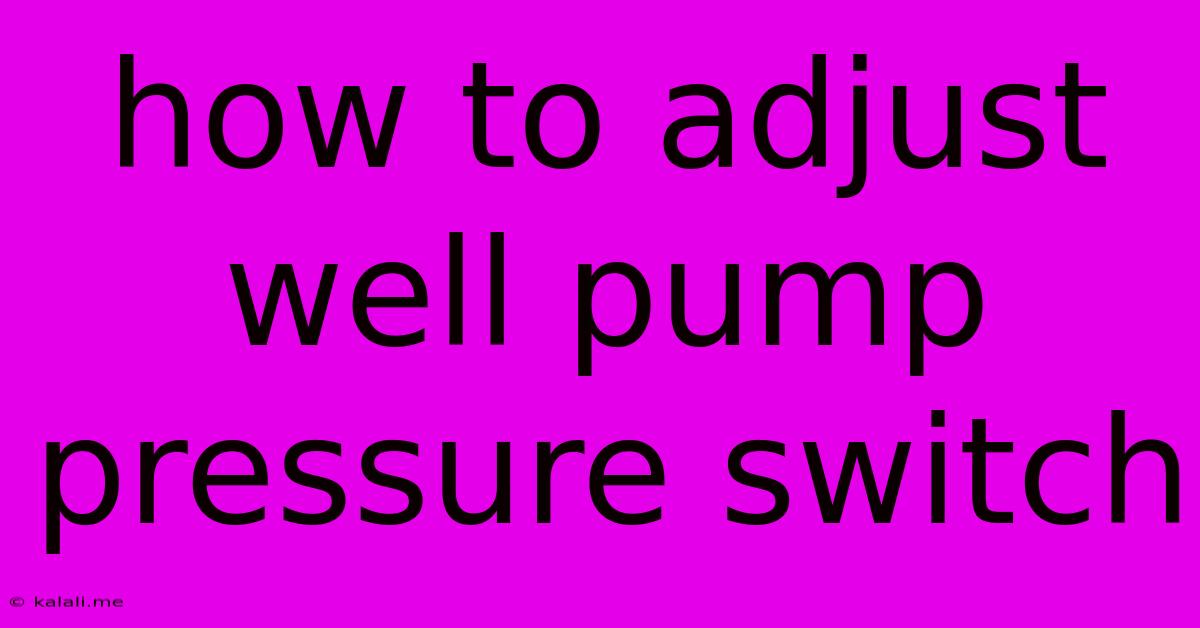How To Adjust Well Pump Pressure Switch
Kalali
Jun 07, 2025 · 4 min read

Table of Contents
How to Adjust Your Well Pump Pressure Switch: A Comprehensive Guide
Meta Description: Learn how to adjust your well pump pressure switch to optimize your water pressure and prevent issues like premature pump wear. This guide provides step-by-step instructions and troubleshooting tips.
Maintaining consistent and adequate water pressure in your home relies heavily on the proper functioning of your well pump pressure switch. This small but crucial component controls when your pump turns on and off, based on the pressure in your water system. If your pressure is too high or too low, it's time to adjust your well pump pressure switch. This guide will walk you through the process safely and effectively.
Understanding Your Well Pump Pressure Switch
Before diving into the adjustment process, it's vital to understand the basics. The pressure switch has two key settings:
- Cut-in Pressure: This is the pressure at which the pump turns on. When the pressure drops below this setting, the switch activates, and the pump starts pumping water.
- Cut-out Pressure: This is the pressure at which the pump turns off. Once the pressure reaches this setting, the switch deactivates, and the pump shuts down.
The difference between these two pressures is called the pressure differential or pump cycle. A typical range is 20-40 PSI (pounds per square inch). A smaller differential leads to more frequent pump cycles, while a larger differential means fewer cycles. Finding the right balance is key to optimal performance and pump longevity.
Tools You'll Need
Before beginning, gather these essential tools:
- Screwdrivers (Phillips and flathead): For adjusting the pressure switch settings.
- Pressure gauge: To accurately measure the pressure in your well water system. A tire gauge won't be precise enough.
- Pen and paper: To record your initial settings and any adjustments you make.
- Safety glasses: To protect your eyes from potential debris.
Step-by-Step Adjustment Process
1. Safety First! Turn off the power to the well pump at the breaker box before you begin. This is crucial for your safety.
2. Locate the Pressure Switch: Usually found near the well pump itself, often mounted on a pipe.
3. Record Initial Settings: Carefully note the current cut-in and cut-out pressures using the pressure gauge and the adjustment screws on the pressure switch. These screws are usually labeled with a "+" and a "–" symbol. The "+" increases pressure, and the "–" decreases it.
4. Adjust the Pressure Switch: Small adjustments (1/4 to 1/2 turn) are recommended. Increase the cut-in pressure by turning the appropriate screw clockwise and increase the cut-out pressure by turning its screw clockwise. To decrease pressures, turn the screws counter-clockwise.
5. Test the Adjustment: Turn the power back on to the well pump. Observe the pressure gauge while using water in your house. Note the actual cut-in and cut-out pressures.
6. Fine-tune Adjustments (if needed): Repeat steps 4 and 5 until you achieve the desired pressure differential. A good starting point is a 20 PSI differential. For instance, a cut-in pressure of 30 PSI and a cut-out pressure of 50 PSI.
Troubleshooting Common Problems
- Low Water Pressure: This could indicate a problem with the well itself, the pump, or the pressure switch. If the pressure switch is adjusted correctly and the problem persists, further investigation is needed.
- Frequent Cycling: A small pressure differential may cause the pump to cycle too often, leading to premature wear. Increase the differential by raising the cut-out pressure.
- Inconsistent Pressure: This points towards a problem with the system, not just the pressure switch. Consider a leaky pipe or a malfunctioning pressure tank.
When to Call a Professional
If you're uncomfortable working with electrical components or plumbing, it’s always best to call a qualified well pump technician. Attempting repairs without proper knowledge can lead to damage or injury. Furthermore, if adjusting the pressure switch doesn't resolve your water pressure issues, professional help is recommended.
By following these steps and understanding the basics of your well pump pressure switch, you can maintain optimal water pressure in your home and extend the lifespan of your well pump. Remember, safety should always be your top priority!
Latest Posts
Latest Posts
-
Can You Use A Drill As A Screwdriver
Jun 07, 2025
-
Did Stephen Hawking Cheat On His Wife
Jun 07, 2025
-
Can Eggshells Go In The Garbage Disposal
Jun 07, 2025
-
Bike Wont Shift Into Lowest Gear
Jun 07, 2025
-
How Much Is 1 Pkg Yeast
Jun 07, 2025
Related Post
Thank you for visiting our website which covers about How To Adjust Well Pump Pressure Switch . We hope the information provided has been useful to you. Feel free to contact us if you have any questions or need further assistance. See you next time and don't miss to bookmark.